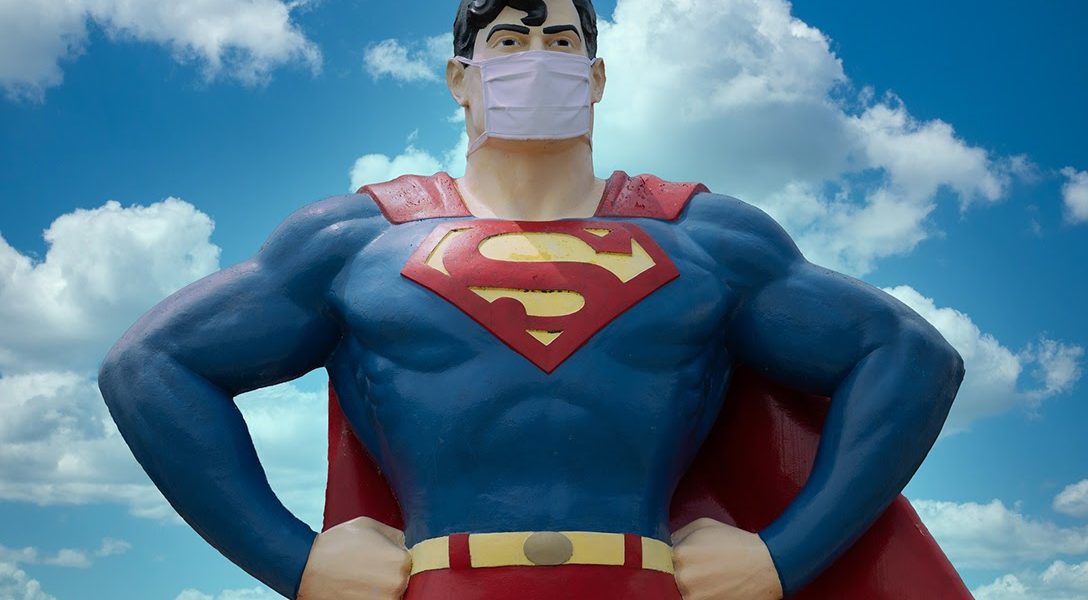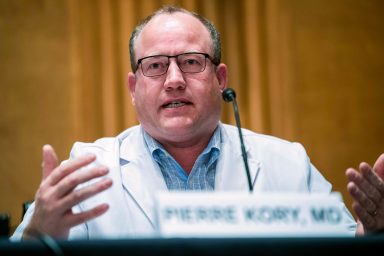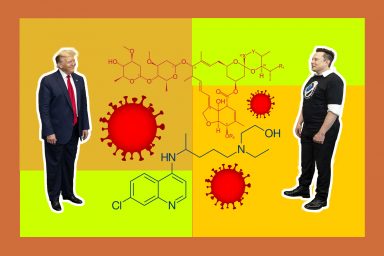As the bodies pile up, so does the misinformation — which in turn leads to more bodies. Yet, there’s hope, if people would only listen to science. But will they?
The irony of the moment is that, the more we learn about COVID-19, the more misinformation is being spread. And while giant leaps are being made in its treatment, current events have raised a whole new series of questions about how we actually deal with it.
According to our guest in this special WhoWhatWhy podcast, Dr. Robert Wachter — professor and chair of the department of medicine at the University of California San Francisco — there is no excuse for the fact that, even seven months into this, doctors have to defend the most basic public health protocols.
He reminds us that being safe doesn’t require chemotherapy or drugs. It’s as simple as wearing a mask. We’ve learned to wear seat belts and not to smoke — so why should this be any different?
He makes clear that, counter to the president’s comments, there is no cure! That 700 Americans a day are still dying from the virus, and he tells us why, if you get sick from it and wind up in an ICU — you have a pretty good chance of not making it out alive.
He explains what monoclonal antibodies really are, what drugs can actually accomplish, who’s at risk, and why superspreader events are the superpower of this virus.
If you’ve been listening to the president and certain senators this past week, you need to hear this conversation to bring you back to reality.



Click HERE to Download Mp3
Full Text Transcript:
As a service to our readers, we provide transcripts with our podcasts. We try to ensure that these transcripts do not include errors. However, due to time constraints, we are not always able to proofread them as closely as we would like. Should you spot any errors, we’d be grateful if you would notify us.
| Jeff Schechtman: | Welcome to the WhoWhatWhy Podcast. I’m your host, Jeff Schechtman. |
| Jeff Schechtman: | In a way, it seems that as doctors and scientists know more about the novel coronavirus, we seem to know less. Giant leaps are being made in the treatment of the disease. Yet, current events have raised a whole new series of questions. |
| Jeff Schechtman: | How long is it contagious? What’s the best treatment? Can spreaders of the disease be completely asymptomatic? Is there a cure? Why do certain places become clusters? And other percentage of deaths dropping, even while the cases continue to rise in so many places? And why are we still debating the proven efficacy of masks? |
| Jeff Schechtman: | Seven months since the national lockdown, a whole new wave of questions are emerging. And a slew of misinformation, particularly from the White House, is rampant. |
| Jeff Schechtman: | For answers, we’re going to turn to Dr. Robert Wachter. He is the professor and chair of the Department of Medicine at the University of California, San Francisco. He is the author of over 300 articles and six books, and coined the term hospitalist, and is often considered the father of the hospitalist field. |
| Jeff Schechtman: | He’s the past president of the Society of Hospital Medicine and past chair of the American Board of Internal Medicine. Several years ago, he was ranked as one of the most influential physician executives in the United States, and has served on the Healthcare Advisory Boards of several companies. |
| Jeff Schechtman: | It is my pleasure to welcome Dr. Robert Wachter to the WhoWhatWhy Podcast. Doctor, thanks so much for joining us. |
| Dr. Robert Wachter: | It’s a great pleasure. Thanks for having me. |
| Jeff Schechtman: | Well, it’s good to have you here. In some ways, with respect to people understanding what’s going on and the realities of the virus, it seems that we’re going backwards in some ways. Talk about that. |
| Dr. Robert Wachter: | Well, we’re certainly seeing a new surge, mostly in the Midwest. That’s disappointing because first of all, a lot of people are going to be harmed and die from it. Second of all, we’re now seven or eight months into it. We should know better. |
| Dr. Robert Wachter: | The first surge in the Northeast in March and April, in some ways, was more forgivable because the disease was spreading before we had widespread testing. We really didn’t understand it very well. |
| Dr. Robert Wachter: | The second one during the summer; June, July; was more disappointing in that we did know what to do. But for many reasons, largely political, people were not doing the right thing. They were not being given the right message. |
| Dr. Robert Wachter: | And this one now, for this to be happening now; seven, eight months into it; is really disheartening. Because one of the things that we’ve learned is this is a nasty virus. Many people were going to die from it, even under the best of circumstances. But we could probably be preventing about 80% of the cases that we’re seeing, if everybody just did the right thing. |
| Jeff Schechtman: | And yet we’re being told at the highest levels that there’s nothing to worry about. That there’s a cure, that we don’t need to worry about masks. |
| Jeff Schechtman: | From a medical point of view, talk about how you and your colleagues react to that. |
| Dr. Robert Wachter: | Well, it just feels like we’re fighting misinformation up a hill all the time. This is not just an academic issue for us, or one of empathy for other people. We have all of that, but we’re also on the front lines. |
| Dr. Robert Wachter: | We’re going in the hospital, taking care of people. It’s just incredibly sad to see people hospitalized, struggling for air, and some of them dying for a disease that could have been prevented in many of the cases. |
| Dr. Robert Wachter: | The amount of bad information people have gotten from the federal government is extraordinary. We know now that masks work amazingly well. Not perfect, but if everybody wore masks, we could probably prevent 70 or 80% of the cases. |
| Dr. Robert Wachter: | The combination of just the simple recommendations; it feels boring to say this, but it’s really not fancy. It’s not like you have to take chemotherapy. It’s masks, it’s distancing, it’s avoiding large crowds. It’s avoiding indoor unventilated spaces if you can. |
| Dr. Robert Wachter: | Those would be preventing probably four out of five of the cases. And to hear messaging that it’s either a hoax or we have the cure, or those things don’t work, or you shouldn’t be too worried about it. |
| Dr. Robert Wachter: | I mean, when I read, “Don’t worry about it,” it’s like, “You got to be kidding me. 220,000 Americans, a million people across the globe have died of this. Yes, you should be worried about it.” |
| Jeff Schechtman: | In all of your work with diseases and situations like this, have you ever seen a situation that’s analogous to this? Where from a public health perspective, people seem to be doing exactly the opposite of what they need to do? |
| Dr. Robert Wachter: | Nothing is quite like this, because I’m not old enough to have been alive in 1918 for the last worldwide pandemic. But I mean, there’s always misinformation. I mean, people don’t always do the right thing. People smoke, people drive too fast. People don’t wear seat belts. This is not an unknown problem. |
| Dr. Robert Wachter: | In this particular world of prevention in healthcare, we see people not taking vaccines and then kids getting sick. We’ve seen poor federal responses to national tragedies. |
| Dr. Robert Wachter: | I live in San Francisco, and the most vivid is AIDS. Where in the early years of the AIDS epidemic, which had a somewhat different flavor in that it had a hundred percent mortality. Everybody who got it died. |
| Dr. Robert Wachter: | But not everybody was vulnerable to it. So it was tending to strike largely the gay population early on. The federal government paid no attention to HIV. President Reagan did not mention the word AIDS in a speech until six years into the epidemic. |
| Dr. Robert Wachter: | Having a poor and politicized federal response is not new. Having people sometimes not do what they should do, in order to protect themselves or protect others, is not new. But I don’t think we’ve ever seen all of it combined in something that looks like this. |
| Dr. Robert Wachter: | And I think particularly with this federal government, we’ve never seen anything quite like this, the amount of misinformation. Pandemics have been gamed out for years. There have been people who do this for a living, try to figure out worst-case scenarios: where it’s going to spread, how should we react? |
| Dr. Robert Wachter: | And in all of those simulations of what the pandemic would look like, there was never a simulation that anybody did that said the President of the United States is going to be the major source of misinformation, as he has been in this case. It was just like, why would you game that out? That’s not going to happen. |
| Dr. Robert Wachter: | It may happen that people are not going to wear masks. It may happen that people don’t do the right thing in this way or the other way. But the idea that the federal government would be the major source of misinformation was not something that was thought to be a realistic possibility. |
| Jeff Schechtman: | In the early stages of the pandemic, particularly on the East Coast, there were so many reports of the deaths that were taking place; of bodies piled up, literally in trucks, behind hospitals. A lot of that scared people. |
| Jeff Schechtman: | We’re not seeing that kind of coverage today. Has that enabled people to let their guard down, do you think? |
| Dr. Robert Wachter: | Yeah, absolutely. I think the early days, yeah, you saw the morgues outside the hospital and the body bags. And I think that scared some people straight. |
| Dr. Robert Wachter: | Now, the coverage is a little bit bloodless. I mean, it’s numbers, and I think we’ve become inured to the numbers. If you thought about this in March, if you had said in October, “We’re still going to be having seven or 800 people a day dying of this thing,” I think people would have been flabbergasted. People would have been shocked. |
| Dr. Robert Wachter: | Now, it’s become almost baked in. It’s like, “Okay, that’s all right. Maybe if it gets to a thousand, we’ll notice.” That’s seven or 800 of our countrymen dying every single day. Think about each one of them, and their lives and their families. It’s an extraordinary tragedy. |
| Dr. Robert Wachter: | But unfortunately this is, to some extent, human nature. People become inured to the statistics over time. They want to get their lives back. They want to move on. Of course, we all do, but the virus hasn’t forgotten us. There’s nothing about the virus that has changed in a meaningful way. It’s still the same. It is still as deadly as it was eight or nine months ago. |
| Dr. Robert Wachter: | And there’s nothing about us that’s changed, except for the five to 10% of us around the country that have already been infected. The 90% of us that are still vulnerable, every bit as vulnerable. |
| Dr. Robert Wachter: | If you let your guard down and the virus happens to be in your community, the dynamics of you getting infected and getting ill and dying are pretty much the same as they were. |
| Dr. Robert Wachter: | There have been some advances in treatments. This is not new for us anymore. As physicians, we know how to take care of the disease in ways that we didn’t. There are things that were very surprising in the beginning, that are less surprising now. Some of the therapies are moderately effective. |
| Dr. Robert Wachter: | The highest-risk people, I think, are being sheltered and being more careful. We’re not seeing the kinds of outbreaks in nursing homes to the same extent that we were seeing in March and April. |
| Dr. Robert Wachter: | The death rate is down a little bit, but it is still a pretty deadly disease. If you’re sick enough to end up in the hospital, and certainly end up in the ICU, you have reasonable odds of not making it out of there alive. |
| Jeff Schechtman: | What have we learned in terms of; and there’ve been several reports from the World Health Organization and other groups; about the transmission of the disease today? We’ve learned a lot about it being more airborne than we originally thought. |
| Dr. Robert Wachter: | Yeah, the terminology gets very confusing. It actually just is confusing because it’s airborne. There are different ways of it being airborne. |
| Dr. Robert Wachter: | What’s been clear all along is that droplets; meaning I sneezed on you, or I coughed on you, or I was speaking loudly; I had virus in the back of my throat, and it just flew into your eyes, nose, or throat. That’s the main way that people get it. |
| Dr. Robert Wachter: | Which is why, if both of us are wearing masks, the chances of that happening go down considerably. If we’re more than six feet apart, the goblets tend not to go that far. Certainly not at a high enough volume that they’re going to get people infected. |
| Dr. Robert Wachter: | We also know that aerosol transmission is possible. It’s less common, but it can happen. What aerosol transmission means, as opposed to droplets, is rather than me directly spraying you with virus; I have virus. I am by the way, I don’t, I think. |
| Dr. Robert Wachter: | But a person has virus; they cough or breathe. There’s now a mist of virus in the air. None of us can see it. The person leaves the room. I enter that space, now I breathe in, and then I can get it. |
| Dr. Robert Wachter: | If that was common, we would be seeing a whole lot more outbreaks than we’ve seen. But we know that it can happen. It can happen, particularly in closed indoor spaces where there’s poor ventilation. So you want to avoid those things. |
| Dr. Robert Wachter: | Again, if the person who had COVID was wearing a mask, that wouldn’t happen because they wouldn’t be leaving this dust trail of virus in the air for the next person to get. |
| Dr. Robert Wachter: | But we know that the things that we are more confident about than we were in March are that it’s mostly this droplet. It can be aerosol in unusual cases. We know that outdoors is far better than indoors, mainly just because of the dispersion. But it’s not 100% protective. |
| Dr. Robert Wachter: | Because if you just think about it, if I’m a foot away from you and I cough or sneeze on you, the fact that you’re outdoors is not all that protective. But it’s better. Ventilation makes a big difference. |
| Dr. Robert Wachter: | So we know all of those things. The surface transmission is not impossible, but far less common than we were worried about. |
| Dr. Robert Wachter: | We know a lot more than we knew about how it’s transmitted. But it doesn’t really change the facts on the ground; the distancing, masking, avoiding large crowds, cleaning your hands. If we all did that, we would markedly decrease the rate of infection. |
| Jeff Schechtman: | Talk a little bit about the contagion aspect of people that are at various stages of the disease. Certainly, what we have been seeing the past week from the president, what we’ve seen from the senator from Utah, who showed up at a hearing today, after testing positive just a few days ago. |
| Dr. Robert Wachter: | Yeah. It’s all pretty shocking. What we know is that if you have COVID, you are contagious before you feel sick. In fact, 30, 40% of people will never feel sick. And yet, they are contagious. |
| Dr. Robert Wachter: | The timeline is you get the disease, you get the virus from somewhere, somebody. Three, four days later, you now have enough virus replicating in the back of your mouth and your nose that you are contagious, but you feel fine. That turns out to be one of the virus’s real superpowers. But we didn’t know that in the beginning. |
| Dr. Robert Wachter: | In the beginning it was all this stuff with temperature checking and symptom inventories. That’s fine, but it certainly can’t be your only defense. Because most people begin to be contagious before they feel sick. And some of them will never feel sick. |
| Dr. Robert Wachter: | If you’re going to go on and begin to feel sick, it’s probably going to happen a day or two later. Then we know that the average person is no longer contagious about 10 days later. But that’s a difficult thing to be sure of in any individual person. |
| Dr. Robert Wachter: | There’s no easily available test that looks for live virus, that can tell us with a hundred percent certainty, that 10 days later is the absolute cutoff. And you’re fine. |
| Dr. Robert Wachter: | In fact, we have seen cases where that time has been longer than 10 days. People have been contagious for longer, particularly if you had a very severe case; the case was severe enough that you were hospitalized. Also, particularly if your own immune system is not as good. We think that’s also if you’ve gotten a drug to suppress your immune system, like prednisone. |
| Dr. Robert Wachter: | So in the president’s case, after 10 days out, he is probably no longer contagious. But not definitively, because he had a severe case, at least at first. He was on steroids. |
| Dr. Robert Wachter: | The safe and prudent thing to do, if you had COVID, is to continue to wear a mask and try to stay away from people for at least another week or two after the 10 days is over. And just the message that it sends for the senator to come in without wearing a mask, it’s shocking. |
| Jeff Schechtman: | What about these drugs that we’re hearing about? We’re being told by the president that it’s a cure. |
| Dr. Robert Wachter: | Yeah. He got three drugs and he’s convinced that one of them was decisive. After his initially scary course, he had a fairly benign course. He’s getting to the point where he’s almost out of the woods. Not quite yet, but another day or two, if he’s fine, he’s probably going to be fine. |
| Dr. Robert Wachter: | Two of the drugs are pretty standard now. If you were sick and came to my hospital, we would give you the antiviral medicine Remdesivir. If you were very sick, we would give you the steroid medicine Dexamethasone. |
| Dr. Robert Wachter: | They’ve been shown to be effective. Dexamethasone lowers the death rate, Remdesivir shortens the length of illness, but hasn’t quite been shown to lower the death rates. But reasonable to give both of those. |
| Dr. Robert Wachter: | The third medicine is this monoclonal antibody. He got a combo of two of them. That’s a medicine that’s designed to give you an engineered antibody instead of what a vaccine will ultimately do, which is stimulate your own body to develop its own antibodies. It makes a lot of theoretical sense. The early and very preliminary studies in a small number of patients are promising, but not definitive. |
| Dr. Robert Wachter: | It’s not generally available. You couldn’t get it. I couldn’t get it. I couldn’t give it to one of my patients today. But he got it because he’s the president. That raises its own ethical questions, but that’s another issue. And he did well. |
| Dr. Robert Wachter: | Whether it was one of the medicines, two or three, or just luck, will never be known. When he first got diagnosed, he probably had a five percent chance of dying. So he had a 95% chance of doing fine. Might’ve gotten sicker, but not dying of the illness. |
| Dr. Robert Wachter: | If he’d gone into a controlled trial; we’re doing a trial at UCSF of the monoclonal antibodies. He would have had a 50/50 chance of getting monoclonal antibodies or a placebo. |
| Dr. Robert Wachter: | If he’d gotten placebo, he had a 19 out of 20 chance of doing fine. I don’t know if he’d be out there doing his infomercials about this miracle drug called Placebo, but here he is. |
| Dr. Robert Wachter: | He doesn’t approach the world in a normally scientific way. There’s no way of knowing if any of the medicines were what, quote, cured him. By the way, that’s not the right word, but he certainly did well. |
| Dr. Robert Wachter: | And certainly the evidence that would support a claim that that particular medicine, the monoclonal antibodies, was the thing that made him better is scanty and a little bit magical. |
| Jeff Schechtman: | Monoclonal antibodies has been something that’s been used for a while as a cancer drug. |
| Dr. Robert Wachter: | Yeah. Actually, it’s a technique that’s been around for a while, and is quite helpful in certain cancers and in certain other inflammatory diseases or infections. It’s not a new thing, but it’s not made it through all of its paces in terms of the testing it needs to have for COVID to be certain that it works. |
| Dr. Robert Wachter: | My guess is that it’s good. My guess is that the preliminary studies are pretty promising, and don’t seem to be showing significant side effects. We’re just waiting for larger studies to prove for sure, statistically sure, that it can’t just be chance that the drugs really are effective. |
| Dr. Robert Wachter: | But if I was a betting man, I would say I think they probably are. I think they’re going to turn out to be a useful part of our armamentarium. I don’t think they are game changers, partly because I don’t think they’re going to be that effective. And partly because there’s a lot of complexity in their use. I’ll just run through a few of them very quickly. |
| Dr. Robert Wachter: | First is we don’t know for sure which people should get it. Giving it to a 74-year-old overweight man who had a pretty high risk; that probably is a reasonable-use case. But which patients are going to get it, which patients are not, is a pretty tricky call. |
| Dr. Robert Wachter: | The second is it’s a pretty hard drug to manufacture. Even though he’s out there saying, “Everybody can get it for free,” the companies say, “The best we can do is produce maybe 50,000 or a hundred thousand doses in the next few months.” That’s how many people are infected a day in the United States. So there’ll be a wildly inadequate supply, even if it turns out it’s useful. |
| Dr. Robert Wachter: | He said it’s going to be available for free. I think it’s going to cost a few thousand dollars. So somebody is going to have to pay that difference, if in fact, it’s going to be available for free. I think nobody really believes that. |
| Dr. Robert Wachter: | It’s not a slam dunk that this medicine is going to come out, be demonstrated to be effective, and then become widely available in a way that’s really going to change the overall trajectory of the illness. |
| Dr. Robert Wachter: | But I do think that a couple of months from now, if you were diagnosed with COVID and you had a very high predicted mortality; let’s say you were 75 years old and you had diabetes and obesity. Your chances of dying from it are in the five to 10% range. |
| Dr. Robert Wachter: | That might be someone who, as we try to ration the medication, because it will have to be rationed; there won’t be enough. That might be someone in whom giving it, the benefits of it outweigh the risk. |
| Jeff Schechtman: | Have we learned more about what co-morbidities pose a higher risk? Is it just being 74 years old? Is it being overweight? Have we learned more about that? |
| Dr. Robert Wachter: | Yeah, well, as I get older, I don’t consider age to be a co-morbidity. I’ll just consider it a fact of life. The co-morbidities are the other illnesses that you have that adds to the risk. |
| Dr. Robert Wachter: | Clearly, age is the most important risk factor. 80-year-olds have predicted mortality rates in the 20% range. Everybody over 60, it gets into maybe the five percent range. Whereas if you take all comers, it’s about 0.6%. |
| Dr. Robert Wachter: | So certainly young people have a far lower rate of dying and getting very sick than older people. That’s the first thing that’s become very clear, is the age is the biggest risk factor. |
| Dr. Robert Wachter: | But layered on top of that, the other things are somewhat predictable. Diabetes, pre-existing heart disease, pre-existing lung disease like emphysema or asthma; even high blood pressure raises your risk. |
| Dr. Robert Wachter: | I think the big surprise here is obesity. For a lot of other diseases, if you’re obese, the chances of you doing worse are a little bit higher. The degree to which obesity markedly raises the risk of a bad outcome is pretty striking for COVID. And nobody really understands why. |
| Dr. Robert Wachter: | For many other diseases, it’s just your body is a little bit more taxed in terms of the ease of breathing. That’s why it’s harder for you to get around. Getting people mobilized and walking around early is a good thing. |
| Dr. Robert Wachter: | But it seems like the risk that obesity confers here; which is at least three or four times that if you take the same age group; three or four times higher than it would be if you weren’t obese. That’s partly why the president’s risk was high, because he’s 74 and he does fall into the moderate obesity category. |
| Dr. Robert Wachter: | Nobody really knows why COVID plus obesity is so risky. People are thinking that it has something to do with actually the fat tissue and the way it deals with the virus. But I think right now it’s mostly hand-waving, but it’s very real. |
| Jeff Schechtman: | When we look at these clusters, like what we’ve seen happen at the White House, what do we learn from those experiences that we can relate to the general population and learn from? |
| Dr. Robert Wachter: | Well, it is yet another superpower of this infection, this propensity to cause superspreader events. If you look at it from a physics standpoint, it’s another thing that’s a little bit unusual about the coronavirus. |
| Dr. Robert Wachter: | For many other infections; everyone’s familiar with this term R0; there’s a certain number that says the average person who has the thing will give it to this many other people. For COVID, without any distancing or masking, that number is about 2.5. |
| Dr. Robert Wachter: | So the average person that gets COVID over the next week or so when they’re infectious, will give it to two and a half other people. If you wear masks and do distancing, that number falls off and below one, which is when the disease starts dying out. |
| Dr. Robert Wachter: | What’s weird; another oddity of COVID is that that’s not a consistent number. It seems like there are some people where their number, rather than being 2.5, is probably less than one just on its own; forgetting even about the masks and the distancing. For some reason, they don’t spread it very much. |
| Dr. Robert Wachter: | For other people, the number is far higher than that. What it is about those people; whether it’s the anatomy of their face and their mouth and their nose; whether it’s that they tend to talk louder or they tend to talk a lot or some other fact that we have not figured out, is basically unknown at this point. |
| Dr. Robert Wachter: | But we do know that if you happen to be that person; and there’s no test that will tell us that. It doesn’t seem to be highly related to the amount of virus you have in you, which you might expect. But it doesn’t seem to be a perfect correlation. |
| Dr. Robert Wachter: | Unfortunately, these people don’t have labels. We don’t know who they are. But if you happen to be one of them, and you happen to be in a setting; particularly indoors with a lot of people and not very much ventilation; there’s a decent chance you will infect not 2.5 other people, but 10 or 20 or 30. |
| Dr. Robert Wachter: | The problem, of course, then, is those people now are infectious. They will go out, infect others. and before you know it, you have a superspreader event and you have exponential growth. |
| Dr. Robert Wachter: | It appears that that’s what happened in the Rose Garden. Whether most of the transmission was outside, which would be unusual. But if you looked at the videos, you saw a lot of people hugging and kissing in that very close quarters with very little masking. |
| Dr. Robert Wachter: | Or as we suspect, some of it was outside, but a lot of it was when they went inside for the reception. Hard to know; we don’t know who the person was in terms of Patient Zero. But that’s how this goes. We’ve seen now a number of those events that have happened in business meetings and in church choirs and all sorts of different circumstances. |
| Dr. Robert Wachter: | But they tend to share the fact that people are not wearing masks. People are in close quarters with each other. There’s poor ventilation. And then there’s bad luck. |
| Jeff Schechtman: | Finally, are you hearing from patients some of this misinformation repeated back to you and your colleagues? And having to deal with that as another aspect of this right now? |
| Dr. Robert Wachter: | Some, but it’s very regional. I live in San Francisco, where by and large, I think people have taken this thing seriously from the beginning. The messaging from our local health leaders and corporate leaders and political leaders has been consistent, and comports with the science. |
| Dr. Robert Wachter: | The proof is in the pudding. Since this thing started, we’ve had 125 deaths in the city of San Francisco. New York is at 25,000. It’s a remarkably low death count in the city. And by far, the lowest death rate per capita of any of the 20 largest cities in the United States. |
| Dr. Robert Wachter: | If you extrapolated our per capita death rate to the entire country, rather than the 220,000 people dead, we’d have about 40,000. We would have saved over 150,000 lives. |
| Dr. Robert Wachter: | I feel pretty lucky to be here, because I don’t hear that too much from my patients and from my friends and family. People generally get it and understand the science. They’re trying to follow it. |
| Dr. Robert Wachter: | Unfortunately, that’s not true in different parts of the country. Some of it has to do with the more libertarian-leaning political philosophy. Some of it has to do with the misinformation people have got from leaders. |
| Dr. Robert Wachter: | But unfortunately, we talk about the risk factors for bad things would be age and co-morbidities. If you look at it, probably the biggest risk factor is whether you believe the science and you’re paying attention to it in your daily activities. |
| Dr. Robert Wachter: | Some of that has to do with what individuals do. But a lot of that has to do with the messages they’re hearing from their leaders. |
| Jeff Schechtman: | Doctor Robert Wachter, I thank you so much for spending time with us here on the WhoWhatWhy Podcast. |
| Dr. Robert Wachter: | My pleasure. It was a great pleasure. |
| Jeff Schechtman: | Thank you. And thank you for listening and for joining us here on Radio WhoWhatWhy. I hope you join us next week for another Radio WhoWhatWhy Podcast. I’m Jeff Schechtman. |
| Jeff Schechtman: | If you liked this podcast, please feel free to share and help others find it, by rating and reviewing it on iTunes. You can also support this podcast and all the work we do by going to WhoWhatWhy.org/donate. |
Related front page panorama photo credit: Adapted by WhoWhatWhy from Becker1999 (Paul and Cathy) / Flickr (CC BY 2.0), Bob Wachter / Twitter, and Adam Fagen / Flickr (CC BY-NC-SA 2.0).



